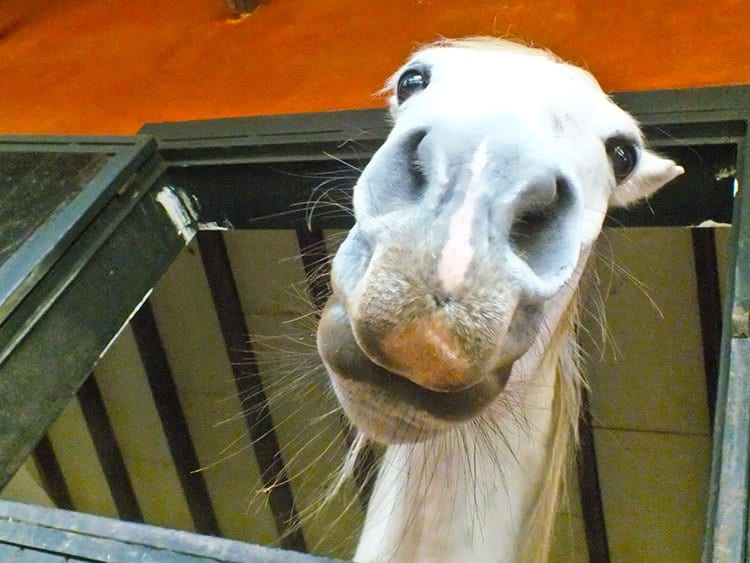[ad_1]

We normally choose up on behavioral issues in efficiency mares after they’re not coaching or performing as much as our envisioned or anticipated potential. Whereas nearly invariably we blame the ovaries and estrus for her lack of focus or undesirable mare conduct, in most situations different elements are at play. Differentiating these from reproductive issues is important to correcting the difficulty.
Undesirable conduct is likely to be associated to bodily abnormalities, coaching issues, or estrous cycle exercise. Widespread complaints from mare house owners embrace again ache, angle modifications, tail-swishing, aggression, kicking, extreme urination, reluctance to maneuver ahead underneath saddle or be separated from different horses, and sensitivity to being touched.
Pinpointing the Reason for Undesirable Mare Habits
When attempting to pinpoint the trigger, your veterinarian will collect an in depth historical past to find out when the conduct happens. You should definitely present an outline of the undesirable conduct and whether or not it’s steady, intermittent, or cyclic. Your veterinarian will then carry out a bodily examination and supplemental diagnostics to rule out causes reminiscent of again ache, lameness, gastric ulcers, urinary tract infections, or dental ache. Whereas tougher to diagnose, your veterinarian may also take into account worry, submissive conduct, or response to dealing with and coaching as potential causes.
To find out if estrus or reproductive points are inflicting behavioral issues, observe whether or not the conduct is definitely related to estrus or an irregular reproductive examination. Notice when the conduct happens relative to estrus, coaching, or publicity to different horses, and have your veterinarian conduct a reproductive examination when the conduct is most extreme. The most typical reproductive situation related to undesirable conduct is a granulosa cell tumor in an ovary.
When you and your veterinarian have pinpointed reproductive pathology (illness or harm) as the reason for the undesirable conduct, it’s normally potential to regulate or alleviate it by eradicating the affected ovary or suppressing estrus.
Treating the Reason for Undesirable Habits
Exogenous progesterone or progestins (the estrous cycle’s dominant hormones) remedy is likely one of the commonest estrous suppression strategies in mares. Each day oral administration of the artificial progestin altrenogest (e.g., Regu-Mate, OvaMed, Altren) may be very efficient and regarded the gold normal. Oral altrenogest’s benefits embrace ease of administration, fixed blood progestin ranges, and no impact on future fertility. The downsides embrace the price of long-term administration, inconvenience of every day dosing, and well being danger to people if absorbed via the pores and skin. Veterinarians have administered different artificial progestins with combined outcomes.
Giving a number of doses of the ovulation induction agent deslorelin acetate (e.g., SucroMate, Ovuplant) would possibly delay estrus, however extra analysis is required to find out if long-term suppression is feasible.
One other strategy to suppress estrus is to lengthen the mare’s corpus luteum (CL) operate—that of the construction chargeable for producing progesterone post-ovulation. This causes the CL to secrete progesterone constantly, blocking estrous conduct. Strategies of extending CL operate embrace the veterinarian inserting a tool reminiscent of a water-filled ball into the uterus, administering the hormone oxytocin, inducing a late diestrus (between estrous cycles) ovulation, terminating an embryo after the interval of maternal recognition of being pregnant, and infusing plant oils into the uterus.
The precise mechanism behind intrauterine gadgets is just not recognized, however researchers theorize that they mimic being pregnant after they contact the endometrium. Issues with this process embrace low efficacy and the problem of sustaining the devise throughout the uterus. If the system is just not ultimately eliminated, it’d stay within the mare for years—doubtlessly unbeknownst to these working together with her—and probably compromising her future fertility.
Benefits of administering oxytocin intramuscularly throughout diestrus embrace diminished value and reversibility, whereas the drawbacks embrace having to manage it every day for seven to 10 days.
Infusing plant oils, reminiscent of coconut or peanut oil, into the uterus to lengthen CL has not been used extensively within the area, however researchers really feel it has potential. Each of those oils are wealthy in fatty acids, which, primarily based on research in cattle and sheep, would possibly modulate prostaglandin synthesis.
Keep in mind, nevertheless, that conduct issues are normally not associated to estrus, wherein estrous suppression is not going to be an answer. On this case work with a veterinarian and a behaviorist to find out the underlying trigger.
[ad_2]
Supply hyperlink
